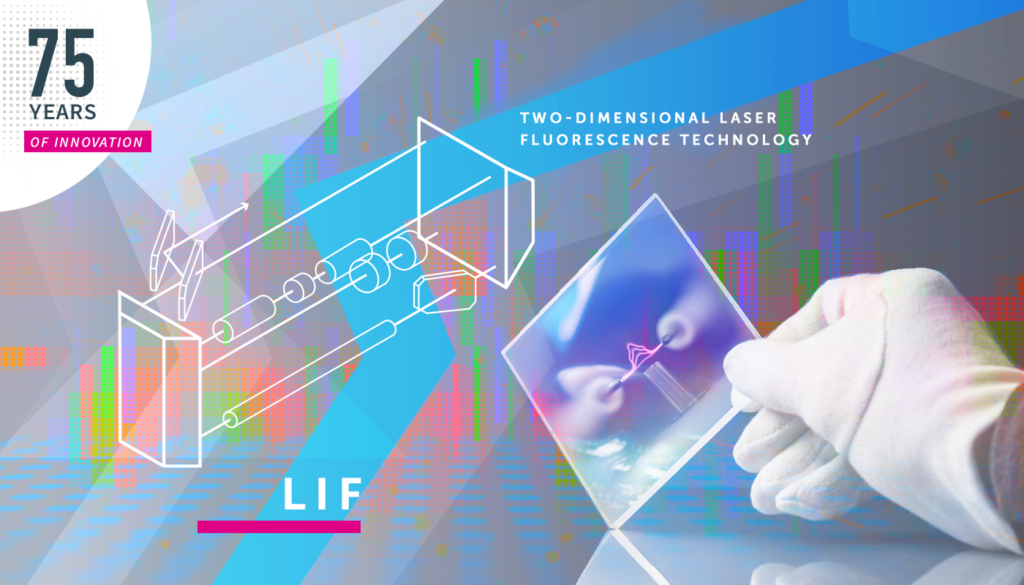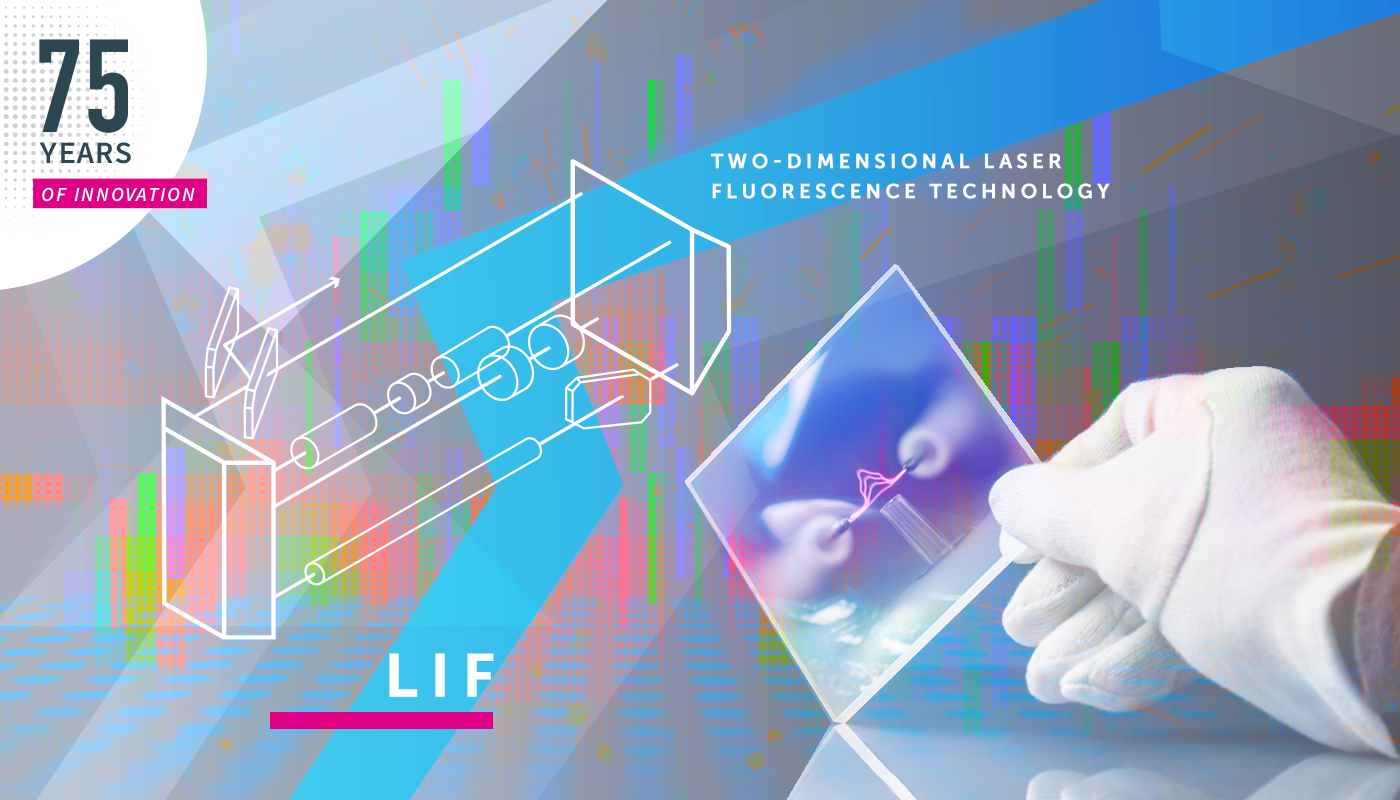The 75 Years of Innovation series highlights the groundbreaking innovations spanning from SRI’s founding in 1946 to today. Each week, SRI will release an innovation, leading up to its 75th anniversary in November 2021.

Back in the early 1980s, SRI International developed a novel technique within the discipline of fluorescence spectroscopy that could be applied to combustion chemistry
What is Two-Dimensional Laser-Induced Fluorescence Spectroscopy (2D-LIF)?
Spectroscopy is a technique used across several scientific disciplines. This includes analytical chemistry where it is used to measure the amount of something, such as an element, within a sample. This seemingly simple task has had enormous benefits for humans. Medicines can be tested for impurities, our drinking water can be analyzed to make sure it is safe to drink, the very air we breathe can be checked for quality. Spectroscopy is abundantly useful in our lives.
There are many types of spectroscopy, but they all come down to one thing, the absorption and emission of light. The scientific basis of spectroscopy is the electromagnetic spectrum: The same rainbow spectrum that is seen when light is passed through a prism. Each color seen represents a different energy or wavelength frequency.
Laser-induced fluorescence spectroscopy (2D-LIF) is another type of spectroscopy. This method is used to detect trace species (chemicals) in a flame, examples being OH, CH, and NCO: i.e. species made from elements such as O, oxygen; H, hydrogen; N, nitrogen; and, C, carbon.
The development of the 2D-LIF technique by SRI led to an important contribution in the field of combustion chemistry and fuel optimization.
I’m the fire starter!
Fire is synonymous with human evolutionary development. But fire is also a chemical reaction that consumes chemical species (fuel) with the resulting output of energy in the form of heat and light. Different types of fuels result in different reaction pathways and different impurities come into play. The optimization of a fuel is a key part of the aviation and automobile industries. This is also intertwined with world economies. To extrapolate this point, ‘combustion chemistry’ may well hold the key to optimal fuel use in a world where fossil fuels are finite and where climate change demands elegant solutions.
Combustion chemistry looks at understanding fuel dynamics to create an optimal fuel profile. To do this, the properties of a fuel and its combustion pathway need to be explored. This is where SRI’s work on laser-induced fluorescence spectroscopy (2D-LIF) enters the picture.
2D-LIF can be used conventionally, to detect the presence of chemical species in a flame. However, the technique goes further. 2D-LIF can show the progress of the combustion and the relative species present at each stage. This ‘real-time’ analysis is a powerful way to understand how a fuel works. A model showing when and where a different excited radical, e.g. OH and NH appears during a combustion cycle, offers researchers insight into the viability of a given fuel.
The technology behind 2D-LIF — A jump of an electron helps make fuel more effective
Technology is usually comprised of several moving parts, each enhancing the previous, working in symbiosis to a common goal. 2D-LIF is no different.
Electrons absorb energy from a laser, which causes the electron to ‘jump’ into another state. This creates energy changes between states that electrons can exist in — this change is used in 2D-LIF to analyze the chemistry of combustion.
Light is made up of different ‘wavelengths,’ each has a different associated energy. An important aspect of spectroscopy is that different types of atoms absorb different ‘wavelengths’. In 2D-LIF, a laser is used to excite the chemical species in fuel. If the emitted energy from the laser is the right fit, an electron will absorb that energy and make a jump: the higher the jump the greater the frequency of wavelength.
The technique that SRI developed is based on “laser-induced fluorescence”. The moving parts of the 2D-LIF system are:
- The laser: This is ‘tuned’ to a wavelength that matches the known absorption wavelength of the molecule the analyst is looking for. This is focused by a cylindrical lens and then passed through the flame. Once irradiated, the atoms within the molecule absorb the laser photons. This causes the electrons to enter an excited state, i.e., make the ‘jump’ between ‘states’. When this happens, a photon is emitted, i.e., fluorescence occurs.
- Filter: The fluorescent photon can then be passed through a spectral filter (if required) to reduce noise from wavelengths that are of no interest.
- Detector: A photomultiplier converts the photons into electrical signals. This creates the “LIF signal”.
- Imaging: An intensified Vidicon tube is used to project an image. Wherever the radical of interest exists in the flame, fluorescence occurs. When focused at right
angles onto this 2D Vidicon tube, the result is an image of the molecular distribution at a given time. This allows the analysis to show changes over time of different chemical species during combustion.
Fossil fuel consumption continues to decline; however, in 2015, fossil fuels still accounted for almost 80% of the world’s fuel consumption. In a period in history when understanding climate change is vital to our future, techniques such as 2D-LIF give us the know-how to optimize fuel use.
Resources
Mark J. Dyer and David R. Crosley, “Two-dimensional imaging of OH laser-induced fluorescence in a flame,” Opt. Lett. 7, 382–384 (1982)
David R. Crosley, “Laser-induced Fluorescence Measurement of Combustion Chemistry Intermediates”, High Temperature Materials and Processes, Vol. 7, №1,1986, 41–54
The World Bank, Fossil fuel energy consumption (% of total): https://data.worldbank.org/indicator/EG.USE.COMM.FO.ZS



